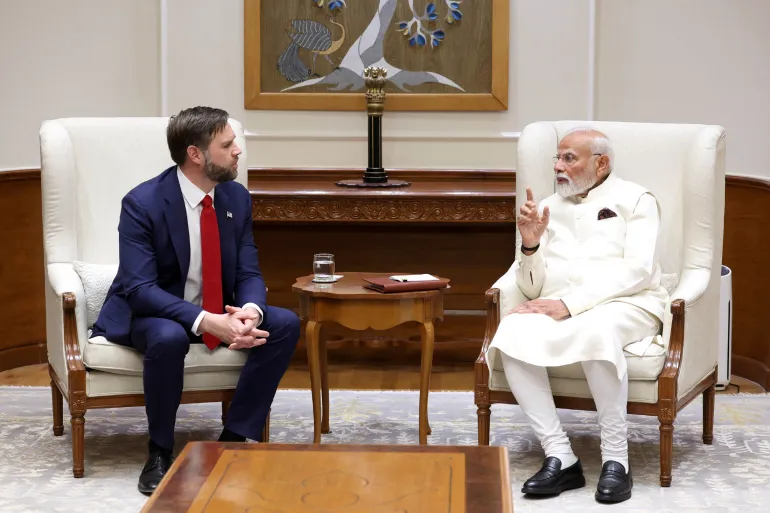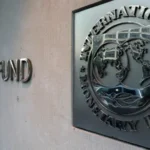United States Vice President JD Vance’s family photo-op with Prime Minister Narendra Modi, complete with hugs and gifts of peacock feathers for his children, presented a warm front. But behind the smiles looms a harder truth: India and the U.S. are facing a potential trade crisis.
U.S. President Donald Trump, in his second term, has revived his aggressive tariff strategy, threatening to impose major levies on imports from countries running trade surpluses with the US. India, which already faces a 10 percent tariff, could see that jump to 26 percent if a bilateral trade deal isn’t reached by July 8, when a temporary pause expires.
That looming deadline explains the urgency behind Vance’s four-day visit to India, which began Monday, and the high-level discussions that followed.
So, how much do India and the U.S. actually trade? And what does each country gain from this relationship?
A Trade Relationship Worth Over $129 Billion
In 2024, bilateral trade between India and the United States stood at $129.2 billion, making the US India’s largest trading partner, slightly ahead of China at $127.7 billion. But unlike the India-China trade equation—which is heavily skewed in Beijing’s favor—India’s trade with the US is mutually lucrative.
India enjoys a significant trade surplus with the U.S. In 2024, India exported goods worth $87.4 billion to the U.S. while importing $41.8 billion, creating a trade surplus of $45.7 billion in India’s favor.
The U.S., meanwhile, ranks 10th among countries with which it has the largest trade deficits. Though this gap is far smaller than the $295 billion deficit the US runs with China, it still places India in the crosshairs of Trump’s “America First” trade policy.
What India Sells—and Buys
India’s exports to the U.S. include pearls and precious stones, electrical machinery, and pharmaceutical products. Organic chemicals, steel, apparel, and textiles also form a significant chunk.
On the flip side, India imports fuel and oils—accounting for nearly 30 percent of U.S. exports to India—alongside medical instruments, nuclear reactor parts, and high-end tech equipment.
Despite these exchanges, tariff differences remain stark. The U.S. imposes an average tariff of 3.3 percent on imports. India’s average stands at 17 percent—and even higher in specific sectors like agriculture, where the average tariff is 39 percent, compared to 4 percent in the U.S.
Trump’s Accusations—and India’s Dilemma
Trump has repeatedly accused India of being a “tariff king” and creating unfair trade barriers. In recent months, India has responded with limited tariff cuts—reducing duties on products like bourbon and Harley-Davidson motorcycles. But key sectors remain shielded.
Agriculture, in particular, is non-negotiable for many in India. Nearly half the country’s population is dependent on farming. Tariffs help protect them from being overrun by cheaper imports, especially from industrial-scale American farms.
“The most striking difference is in the agriculture sector, where India’s tariffs are notably higher,” said a February report by the Indian Council for Research on International Economic Relations (ICRIER).
Can India and the U.S. Strike a Deal in Time?
Indian officials are hoping to finalize the first phase of a trade deal by the end of the year, but that timeline may not align with Trump’s July 8 deadline. The 90-day pause on tariff hikes was intended to push countries like India into quicker negotiations.
However, experts warn that Trump’s coercive style could backfire. “Trump doesn’t want rules in trade,” said Biswajit Dhar, trade economist and former professor at Jawaharlal Nehru University. “India has to ensure that it’s a win-win situation.”
That means walking a tightrope: satisfying American demands for greater access to Indian markets—especially in agriculture—while avoiding domestic political backlash from farmers, some of whom are already protesting against the visit.
The Bigger Picture
Despite political differences, both countries recognize the strategic value of a robust partnership. India is central to the U.S.’s Indo-Pacific strategy to counter China’s rise. For India, the U.S. is a vital ally and export market.
But economics often trumps diplomacy—and unless a trade deal can be reached, the coming weeks may test just how far this partnership can stretch under pressure.






